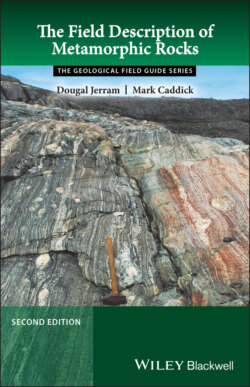Читать книгу The Field Description of Metamorphic Rocks - Dougal Jerram - Страница 14
1.2 Understanding Metamorphism; Pressure/Temperature Relationships
ОглавлениеRocks undergo metamorphic and metasomatic changes as they are subjected to different pressure and temperature conditions, or are infiltrated by chemically reactive fluids. Indeed, a fundamental building block to a deeper understanding of metamorphism is a good grasp of pressure, temperature, and time (it takes time for metamorphic reactions to take place, evidence of which may be preserved in the field in the form of incomplete reactions). In this sense, it is very useful from the onset of your training as a metamorphic Earth scientist to become familiar with the ranges of pressure and temperature experienced in the Earth and the key metamorphic mineral associations (assemblages) that are found within these ranges. One of the main ways in which we consider this is through what is known as a P/T diagram, in which changing aspects of a rock are plotted as a function of pressure (P) and temperature (T). This allows one to highlight various aspects of metamorphism and question how they might be represented in the field. P/T diagrams will appear throughout this text to help understand the types and styles of metamorphism, and will feature specifically in Chapter 3 in relation to the main classification of metamorphic rocks, and in associated tables within the reference Chapter 8.
At this introductory stage it is useful to consider the basic P/T diagram in relation to the relative intensity of metamorphism, as this forms a good basis for understanding under what conditions the different types of metamorphic rocks are formed. Figure 1.2 shows a P/T diagram (with approximate depths included) that expands on the key ‘facies’ concept (originally described by Pentti Eskola in 1915), namely that rocks of a similar composition will, when subjected to the same P/T conditions, form the same mineral assemblages. You can also see how this relates to the main tectonic settings by referring the numbers on the trends to the locations on Figure 1.1. The fields in Figure 1.2 thus map out the P/T stabilities of major mineral assemblages that could form in a metamorphosed mafic rock (e.g. a basalt) as a general reference. A far more detailed and subtle record of mineral reactions almost certainly occurs in most rocks and will be discussed in subsequent chapters, but the reactions at the boundaries of these fields are significant enough that the metamorphic facies (and thus approximate metamorphic P/T conditions) of a mafic rock can generally be identified in the field. Generally speaking, Figure 1.2 suggests that low grade metamorphism starts around 150–200 °C and ~3 kbar (300 MPa, or ~10 km depth). As temperature and pressure increase, the grade of metamorphism progressively increases accordingly until, at temperatures of 600–800 °C (or greater), the rocks themselves begin to melt and we start to enter the realm of igneous petrogenesis. These fields and the main ways in which we classify metamorphic rocks will be discussed in detail in Chapter 3, and as you go along you will see that the P/T of the rocks can be displayed in a variety of diagrammatic forms.
